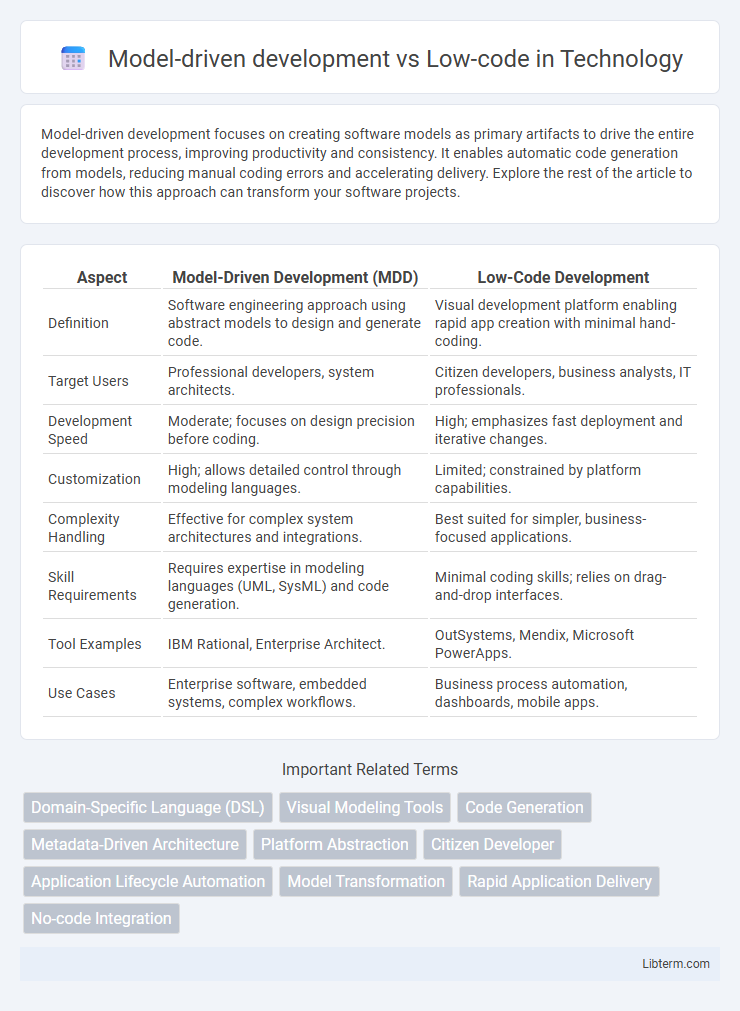Model-driven development focuses on creating software models as primary artifacts to drive the entire development process, improving productivity and consistency. It enables automatic code generation from models, reducing manual coding errors and accelerating delivery. Explore the rest of the article to discover how this approach can transform your software projects.
Table of Comparison
| Aspect | Model-Driven Development (MDD) | Low-Code Development |
|---|---|---|
| Definition | Software engineering approach using abstract models to design and generate code. | Visual development platform enabling rapid app creation with minimal hand-coding. |
| Target Users | Professional developers, system architects. | Citizen developers, business analysts, IT professionals. |
| Development Speed | Moderate; focuses on design precision before coding. | High; emphasizes fast deployment and iterative changes. |
| Customization | High; allows detailed control through modeling languages. | Limited; constrained by platform capabilities. |
| Complexity Handling | Effective for complex system architectures and integrations. | Best suited for simpler, business-focused applications. |
| Skill Requirements | Requires expertise in modeling languages (UML, SysML) and code generation. | Minimal coding skills; relies on drag-and-drop interfaces. |
| Tool Examples | IBM Rational, Enterprise Architect. | OutSystems, Mendix, Microsoft PowerApps. |
| Use Cases | Enterprise software, embedded systems, complex workflows. | Business process automation, dashboards, mobile apps. |
Introduction to Model-Driven Development and Low-Code
Model-driven development (MDD) emphasizes creating software through abstract models, enabling automatic code generation and reducing manual coding effort. Low-code platforms provide visual interfaces and pre-built components to accelerate application development with minimal hand-coding. Both approaches aim to improve software delivery efficiency but differ in abstraction level and flexibility for customization.
Core Principles of Model-Driven Development
Model-driven development (MDD) centers on creating and exploiting domain models as primary artifacts, enabling automatic code generation and reducing manual coding errors. MDD emphasizes abstraction through meta-models, separation of concerns, and platform independence to enhance scalability and maintainability. Unlike low-code platforms, which prioritize rapid visual application building, MDD focuses on formal modeling techniques and systematic transformation of models into executable code.
Key Features of Low-Code Platforms
Low-code platforms offer visual development environments with drag-and-drop interfaces that accelerate application creation by minimizing manual coding. They provide reusable components, pre-built templates, and integrations with various systems, enabling rapid prototyping and deployment. Built-in governance, security features, and collaboration tools support enterprise scalability and compliance in low-code development.
Differences in Development Approaches
Model-driven development emphasizes creating software through abstract models that are systematically transformed into code, prioritizing domain-specific languages and formal modeling techniques. Low-code platforms rely on visual interfaces and pre-built components, enabling rapid application assembly with minimal hand-coding, targeting faster deployment and broader accessibility. The key difference lies in the abstraction level and flexibility, with model-driven development offering deeper customization through modeling, while low-code focuses on speed and ease of use via drag-and-drop tools.
Advantages of Model-Driven Development
Model-driven development offers enhanced precision by using formal models to define system architecture, improving clarity and reducing errors. It promotes better maintainability through automatic code generation and synchronization between models and implementation. This approach supports complex system design and scalability, making it ideal for enterprise-level applications where high customization and control are essential.
Benefits of Low-Code Solutions
Low-code solutions accelerate application development by enabling users with minimal coding skills to create functional software rapidly, reducing time-to-market and lowering development costs. These platforms offer visual modeling tools and pre-built components that simplify complex processes, enhancing collaboration between business and IT teams. Enhanced scalability and integration capabilities make low-code solutions ideal for agile enterprises seeking faster innovation and continuous delivery.
Use Cases: When to Choose Model-Driven Development
Model-driven development (MDD) is ideal for complex enterprise applications requiring high customization, extensive business logic, and formal system architecture. It excels in scenarios demanding robust integration with existing legacy systems and where precise control over code generation ensures maintainability and scalability. When use cases involve regulatory compliance, detailed documentation, and iterative refinement, MDD provides a structured framework unmatched by low-code platforms.
Use Cases: When to Choose Low-Code Platforms
Low-code platforms excel in rapidly developing business applications where speed and ease of use are critical, especially for non-developers or citizen developers. They suit scenarios requiring quick prototyping, workflow automation, and integration with existing enterprise systems without deep coding expertise. Enterprises aiming for faster time-to-market or iterative development cycles should choose low-code solutions to accelerate digital transformation and reduce reliance on traditional software development resources.
Challenges and Limitations of Each Approach
Model-driven development faces challenges such as complex tooling requirements and steep learning curves for developers, which can slow down adoption and increase project costs. Low-code platforms often struggle with limited customization, scalability issues, and potential vendor lock-in, restricting flexibility for complex enterprise applications. Both approaches require careful evaluation of project needs to balance rapid development with maintainability and long-term control.
Future Trends in Model-Driven and Low-Code Development
Future trends in model-driven and low-code development emphasize greater integration of AI and machine learning to automate complex code generation and enhance user customization. The rise of cloud-native architectures and containerization is driving scalable deployment and collaboration across distributed teams. Increasing adoption of industry-specific accelerators and real-time analytics is accelerating development cycles and improving application adaptability in dynamic business environments.
Model-driven development Infographic

 libterm.com
libterm.com